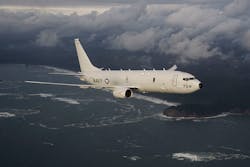Boeing to provide upgrades to airborne anti-submarine warfare (ASW) sonar system aboard Navy's P-8A Poseidon
PATUXENT RIVER NAS, Md. – Military avionics experts at the Boeing Co. will provide upgrades to a long-range anti-submarine warfare (ASW) system aboard the U.S. Navy P-8A Poseidon maritime patrol aircraft under terms of a $24 million order announced in late May.
Officials of the Naval Air Systems Command at Patuxent River Naval Air Station, Md., are asking the Boeing Defense, Space & Security segment in Huntington Beach, Calif., to provide additional software builds for the Multi-static Active Coherent Enhancements (MAC-E) program.
The MAC-E project involves upgrades and technology insertion for the Navy's Multistatic Active Coherent Capability (MAC), a sonar subsystem that uses the SSQ-125 sonobuoy to generate loud sounds electronically rather than with small explosive charges.
These sounds travel long distances through ocean waters and reflect off large objects like submarines or other submerged structures to help Navy ASW specialists detect and track potentially hostile submarines.
This contract modification exercises an option to procure additional software builds to provide correction of deficiencies, to include software enhancements or improvements, engineering analyses and evaluations, and integration and test in support of the P-8A Increment 3 C-MAC program.
The SSQ-125 sonobuoy intercepts long-range echoes from submarine contacts and relays them to the P-8A's airborne sensor system. Navy officials say that electronic sound sources generate fewer false returns than do explosive charges.
MAC-E is intended to hasten enemy submarine detection and engagement, and to enable the P-8A to search large areas of the ocean quickly with enhanced precision. Planned MAC-E capabilities will include increased search rate, clutter reduction, and operator-machine interface improvements.
On this order Boeing will do the work in Huntington Beach, Calif.; Patuxent River, Md.,; and California, Md., and should be finished by February 2024. For more information contact Boeing Defense, Space & Security online at www.boeing.com/company/about-bds.
About the Author
John Keller
Editor-in-Chief
John Keller is the Editor-in-Chief, Military & Aerospace Electronics Magazine--provides extensive coverage and analysis of enabling electronics and optoelectronic technologies in military, space and commercial aviation applications. John has been a member of the Military & Aerospace Electronics staff since 1989 and chief editor since 1995.
